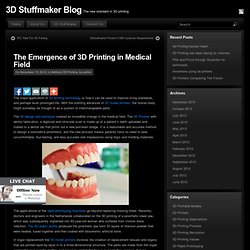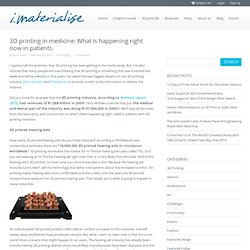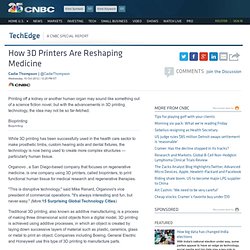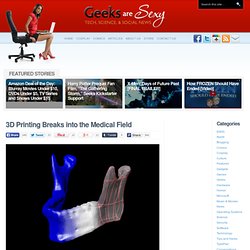

Applications of 3D Printers in Medical Field. The major application of 3D printing technology is how it can be used to improve living standards, and perhaps even prolonged life.

With the startling advances in 3D model printers, the human body might someday be thought of as a system of interchangeable parts. The 3D design and prototype created an incredible change in the medical field. The 3D Printers with dental fabrication, a digitized and intra-oral scan is made up of a patient`s teeth uploaded and mailed to a dental lab that prints out a new porcelain bridge. It is a reasonable and accurate method to design a restorative prosthesis, and the new process means patients have no need to bear uncomfortable, foul-tasting, and less accurate oral impressions using trays and molding materials. The applications of the rapid prototyping machines go beyond replacing missing limbs. 3D Printing for Medical Manufacturing. For highly accurate surgical guides and prototypes that mimic the look and feel of the finished medical device, including clear and rubberlike materials, Stratasys offers Objet 3D Printing.

Digital material 3D printers can output a range of textures from rigid to flexible. For strong tooling, custom fixtures and end-use parts, Fused Deposition Modeling (FDM) Technology works with production-grade materials, including high-performance thermoplastics. Learning Initiative 7 Things You Should Know About 3D Printing - ELI7086.pdf. Medical - On 3D Printing. The list of medical applications for 3D printing was originally compiled by the team at 3D model marketplace CGTrader and has been edited for publication here.

Recently 3D printing has been a hot mainstream trend, but there are thousands of people who are still not aware of this mind-blowing technology. Obviously, 3D printing is being carefully watched by scientists, designers, futurists, and hobbyists. No doubt, it will change our lives; 3D printing is already reshaping them. In the long run, 3D printing may have the most impact in the medical field, where extrusion of living cells instead of plastic material in a 3D printer has led to bioprinting. Here is a completely mind-blowing list of the top 9 ways 3D printing has already changed all the branches of the medicine and what to expect in the future. 3D printing and medicine: What is happening right now in patients. I applaud all the attention that 3D printing has been getting in the media lately.

But, I’ve also noticed that many people are now thinking that 3D printing is something that was invented last week and will be relevant in five years. I’ve asked the two biggest experts on the 3D printing industry Terry Wohlers and Phil Reeves to provide us with some information to redress the balance. Did you know for example that the 3D printing industry, according to Wohlers report 2010, had revenues of $1.068 billion in 2009? Terry Wohlers told me that just the medical and dental part of the industry was doing $157,000,000 in 2009. We”ll skip all the news from the laboratory and concentrate on what”s been happening right now in patients with 3D printing medicine. How 3D Printers Are Reshaping Medicine. "This is disruptive technology," said Mike Renard, Organovo's vice president of commercial operations.

"It's always interesting and fun, but never easy. " (More:15 Surprising Global Technology Cities) Traditional 3D printing, also known as additive manufacturing, is a process of making three dimensional solid objects from a digital model. 3D printing is achieved using additive processes, in which an object is created by laying down successive layers of material such as plastic, ceramics, glass or metal to print an object. Companies including Boeing, General Electric and Honeywell use this type of 3D printing to manufacture parts. Bioprinters, though, use a "bio-ink" made of living cell mixtures to form human tissue.
Eventually, medical researchers hope to be able to use the printed tissue to make organs for organ replacement. Bioengineers at Cornell University have printed experimental knee cartilage, heart valves and bone implants. "We build custom tissue for them," Renard said. 3D Printing Breaks into the Medical Field. Photo Credit: organprinter So we’ve all definitely heard the hype surrounding the 3D printing technology.

Yes, it’s been around for a while, but it’s now taking off like a whirlwind – with everything from 3D remote control aeroplanes to opening a whole new range of sculptural artistry – and it seems like the Star Trek replicators are not so far fetched after all. Last year, orthopaedic specialists were already delving into the world of 3D printing to see how it might benefit the medical community. Tests on animals showed that 3D printed bone scaffolds could be attached to assist in bone growth repairs – a technology they hope to make viable for humans within the next two decades. However, what they didn’t realize was that doctors in the Netherlands were way ahead of them; they just hadn’t talked about it yet. The patient was an elderly woman of 83 years who had developed a chronic bone infection in her lower jaw.
Three Practical Uses of 3D Printers in the Medical Field.